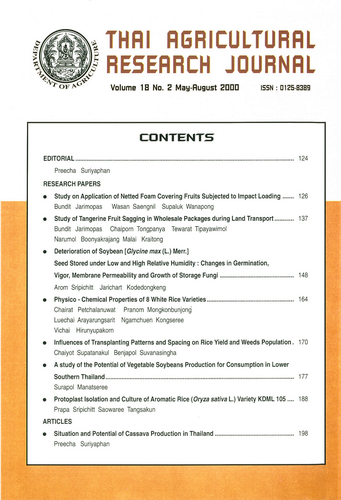Protoplast Isolation and Culture of Aromatic Rice (Oryza ativa L.) Variety KDML 105
DOI:
https://doi.org/10.14456/thaidoa-agres.2000.21Keywords:
rice (Oryza sativa L.) protoplast inolation, protoplast cultureAbstract
Protoplasts were isolated from 3 sources of cells; leaves of seedlings, embryo-derived calli and cell suspension by incubating them in enzyme solution containing various kinds and concentrations of enzymes for 1, 3 and 5 hrs, repecitively. The results showed that leaves from 5-day-old seedlings was the most suitable source of cells for protoplast isolation which gave the highest yield of protoplasts 9.14 x 10 per 1 g fresh weight of leaves. The kinds and concentrations of enzymes optimum for protoplast isolation were different depended on the sources of cells used for isolation. The enzyme solution containing 2% cellulase Onozuka RS, 1% macerozyme R 10 and 0.1% pectolyase was suitable for isolation of protoplast from the leaves whereas calli and cell suspension gave high yielded protoplasts when incubated in enzyme solution containing 4% cellulase Onozuka RS, 1% macerozyme R 10 and 0.2% pectolyase. The incubation period of 3 hrs was optimum for protoplast isolation from leaves, calli and cell suspension. However, protoplasts isolated from cell suspension possessed hgiher percentage of viability (80-90%) than protoplasts isolated from leaves and calli (50-60%). The isolated protoplast could not divide to form colony or callus when cultured on N6 or K8P medium
Downloads
Published
How to Cite
Issue
Section
License

This work is licensed under a Creative Commons Attribution-NonCommercial-NoDerivatives 4.0 International License.
Thai Agricultural Research Journal



